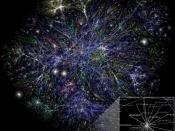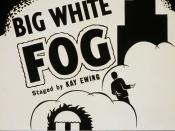"Traditional Japanese theatrical forms, although unique in nature, hold relevance for contemporary audiences and performers."
...................The Essence of Noh Theatre...................
The fundamental principle of Noh theatre can be illustrated using the Zen term 'Yugen' meaning 'beauty that is felt'.["Back to Beckett" (Internet)]. This old form of traditional Asian theatre is not a 'drama' as the word is used nowadays. It is closer to a representation of a metaphor. Noh performers will represent the essence of an animal or emotion, as opposed to literally imitating it. As such, an actor portraying sadness (with the use of the 'weeping' hand gesture) would not look very sad, as far as a western audience member may be concerned. The viewers are expected the use their imagination to appreciate the messages the actors are trying to portray, and are expected to create the scenery and environment themselves, as Noh stages are very bare and simplistic.
Noh performers place huge importance on the aesthetics of their plays. The costumes and masks (generally worn by the Shite* only) are crafted with elaborate precision, just as every gesture and movement is perfectly accurate and refined. The prose in Noh plays has a poetic and often rhythmic structure to it, similar to a modern 'haiku' poem. ["Encyclopedia: Noh Theatre" (Internet)]. This prose is chanted, but the singing is not very melodic as it involves long repeats with limited tonal and dynamic range.
There are 5 types of Noh plays: God plays (Kami) - which praised the Gods; Warrior plays (Shura) - in which the slain protagonist returns as a ghost; Woman plays (Katsura) - very elegant in style, with a female protagonist, Mad Woman plays (Gendai) and Demon plays (Kiri) - in which the demon and the hero fight. ["Noh Theatre" (Internet)]
...................About the Play 'Kinuta'...................
The play "Kinuta' is a Woman play (Katsura) as it tells the story of a wife, alone and terribly heartbroken without her husband. As with all Katsura plays, it is very elegant in style.
As mentioned previously, Noh plays use a lot of symbolism and representation. In the Wife's speech beginning with 'Sorrow!--' mandarin ducks are mentioned twice. Mandarin ducks are often associated with love and loyalty because they mate for life. The separation of the Wife from her husband is reflected in the images of these ducks, as well as in the fish 'being held apart in the waves'.
This same speech also successfully creates a sad and gloomy atmosphere with the specific vocabulary choices and vivid imagery. Words such as 'silence' and 'clearing' set up the mood of the play and position the audience to share Wife's feeling of isolation. The poignant picture created in one's mind with the lines 'I do not forget to weep / At the sound of the rain upon you, / My tears are a rain in the silence, O heart of the seldom clearing' significantly contributes to the depressing feel of the scene.
Although in Noh plays the Shite is the only main character, the chorus in Kinuta have a significant role too. Throughout the whole play they comment on the situations the characters are in and are especially used as a device to position the audience. For example: their prose beginning with 'As the decline of autumn' serves to position the audience to pity the woman ('Upon what shall she lean to-morrow?'). They also help move the play forward, especially in respect to the passing of time, by mention of seasons.
The audience members are expected to picture the location themselves, and are only given hints as to what it would like. The mentions of Autumn make the viewers imagine bare, twisted trees, cold winds and floors littered with dead leaves. All of this is symbolic of the emptiness and loneliness central to this play.
...................Its Modern-day Relevance...................
Noh is a very old form of Asian Theatre, and in great contrast to what modern Western or European audiences are used to. Watching traditional Japanese plays would be a very valuable experience for these people, as it would teach them to appreciate and respect a totally different form of visual art. Noh plays are very visual and rely on things being 'seen' for the story to be told, as opposed to something having to 'happen'.
Australian Drama is very raw, blunt and 'in your face'. It comes as a pleasant relief to watch a play so beautifully refined with such amazing precision and aesthetics. Modern theatre-goers could do with some more cultural diversity, and though they do not have to like everything they see, many people in the Performing Arts industry consider it important that audiences experience something different occasionally.
_________________________BIBLIOGRAPHY_________________________
Unknown author (1996) Background to Noh-Kyogen (Internet) Available from: http://www.iijnet.or.jp/NOH-KYOGEN/english/english.html (Accessed 4th Nov '04)
Back to Beckett (Internet) Available from: http://wwwstaff.murdoch.edu.au/%7Eserge/serge/Research.htm#Noh (Accessed 4th Nov '04)
Encyclopedia: 'Noh Theatre' (Internet) Available from:
http://encyclopedia.thefreedictionary.com/Noh%20theatre (Accessed 3rd Nov '04)
McDonald, M. (1994) 'Fusing Greek and Asian Drama' Didaskalia: Ancient Theatre Today. Vol.1, no.4, October. Available from: Didaskalia - The Journal. (Online) (Accessed 3rd Nov '04)
Noh and Kyogen (Internet) Available from: http://web.archive.org/web/20020602063830/www.kt.rim.or.jp/%7Esnoo/IntroE.html (Accessed 4th Nov '04)
Noh Theatre (Internet) Available from: http://faculty.winthrop.edu/fletchera/Noh.htm (Accessed 28th Oct '04)
Japanese Noh Theater (Internet) Available from: http://artelino.com/articles/noh_theater.asp (Accessed 1st Nov '04)
'no theatre' Encyclopædia Britannica. Available from: Encyclopædia Britannica Premium Service (Online)
(Accessed November 1, 2004)


